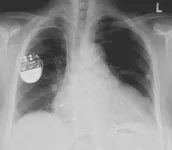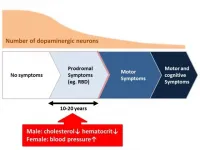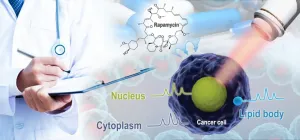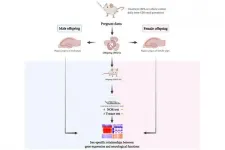(Press-News.org) A new type of ultra-efficient, nano-thin material could advance self-powered electronics, wearable technologies and even deliver pacemakers powered by heart beats.
The flexible and printable piezoelectric material, which can convert mechanical pressure into electrical energy, has been developed by an Australian research team led by RMIT University.
It is 100,000 times thinner than a human hair and 800% more efficient than other piezoelectrics based on similar non-toxic materials.
Importantly, researchers say it can be easily fabricated through a cost-effective and commercially scalable method, using liquid metals.
Lead researcher Dr Nasir Mahmood said the material, detailed in a new Materials Today study, was a major step towards realising the full potential of motion-driven, energy-harvesting devices.
"Until now, the best performing nano-thin piezoelectrics have been based on lead, a toxic material that is not suitable for biomedical use," Mahmood, a Vice-Chancellor's Research Fellow at RMIT, said.
"Our new material is based on non-toxic zinc oxide, which is also lightweight and compatible with silicon, making it easy to integrate into current electronics.
"It's so efficient that all you need is a single 1.1 nanometre layer of our material to produce all the energy required for a fully self-powering nanodevice."
The material's potential biomedical applications include internal biosensors and self-powering biotechnologies, such as devices that convert blood pressure into a power source for pacemakers.
The nano-thin piezoelectrics could also be used in the development of smart oscillation sensors to detect faults in infrastructure like buildings and bridges, especially in earthquake-prone regions.
Examples of energy-harvesting technologies that could be delivered by integrating the new material include smart running shoes for charging mobile phones and smart footpaths that harness energy from footsteps.
Flexible nanogenerator: how the material is made
The new material is produced using a liquid metal printing approach, pioneered at RMIT.
Zinc oxide is first heated until it becomes liquid. This liquid metal, once exposed to oxygen, forms a nano-thin layer on top - like the skin on heated milk when it cools.
The metal is then rolled over a surface, to print off nano-thin sheets of the zinc oxide "skin".
The innovative technique can rapidly produce large-scale sheets of the material and is compatible with any manufacturing process, including roll-to-roll (R2R) processing.
The researchers are now working on ultrasonic detectors for use in defence and infrastructure monitoring, as well as investigating the development of nanogenerators for harvesting mechanical energy.
"We're keen to explore commercial collaboration opportunities and work with relevant industries to bring future power-generating nanodevices to market," Mahmood said.
INFORMATION:
The research is supported through funding from the Australian Research Council and the ARC Centre of Excellence in Future Low-Energy Electronics Technologies (FLEET).
The team acknowledges the support of the RMIT Micro Nano Research Facility (MNRF) and Microscopy and Microanalysis Facility (RMMF), CSIRO, the Multi-modal Australian Science Imaging and Visualisation Environment (MASSIVE), National Computational Infrastructure National Facility and the Pawsey Supercomputer Centre.
'Maximum piezoelectricity in a few unit-cell thick planar ZnO - A liquid metal-based synthesis approach', with collaborators from UNSW and Deakin University, is published in Materials Today (DOI: 10.1016/j.mattod.2020.11.016).
A research team led by Nagoya University in Japan has found that blood pressure, the hematocrit (the percentage of red blood cells in blood), and serum cholesterol levels change in patients with Parkinson's disease long before the onset of motor symptoms. This finding, which was recently published online in Scientific Reports, may pave the way for early diagnosis and treatment of the disease.
Parkinson's disease, the second most common disease affecting the nervous system after Alzheimer's disease, is caused by a deficiency in a neurotransmitter called dopamine. It is known that more than half of all dopaminergic neurons are already lost in patients with Parkinson's disease in the stage wherein they ...
India has an energy problem. It currently relies heavily on coal and consumer demand is expected to double by 2040, making its green energy targets look out of reach. Part of the solution could come from harvesting energy from footsteps, say Hari Anand and Binod Kumar Singh from the University of Petroleum and Energy Studies in Dehradun, India. Their new study, published in the De Gruyter journal Energy Harvesting and Systems, shows that Indian attitudes towards power generated through piezoelectric tiles are overwhelmingly positive.
Cities like Delhi and Mumbai are famously crowded, especially at railway stations, temples and big commercial buildings. This led researchers to wonder whether piezoelectric tiles, which produce ...
Researchers have used the world's smallest, smartphone-sized DNA sequencing device to monitor hundreds of different bacteria in a river ecosystem.
Writing in the journal eLife, the interdisciplinary team from the University of Cambridge, UK, provide practical and analytical guidelines for using the device, called the MinION (from Oxford Nanopore Technologies), to monitor freshwater health. Their guidelines promise a significantly more cost-effective and simple approach to this work outside the lab, compared to existing methods.
Rowers and swimmers in Cambridge are regularly affected by waterborne infections such as Weil's disease, sometimes leading to public closures of the city's iconic waterways. Monitoring the microbial species in freshwater ...
Whether consciously or unconsciously, automotive firms time their product recalls to minimize stock price penalties, resulting in unnecessary delays and clusters of subsequent recalls by other companies, according to new research from the University of Notre Dame.
An initial recall by one firm prompts clusters of additional recalls in close proximity by competitor firms, according to "Hiding in the Herd: The Product Recall Clustering Phenomenon," forthcoming in Manufacturing and Service Operations Management from Kaitlin Wowak, assistant professor of IT, analytics, and operations at Notre Dame's Mendoza College of Business.
According to the study, "Automobile recalls seem to be announced after inexplicable delays. Toyota's unintended acceleration recall and General ...
Nearly 78 per cent of children with autism have at least one mental health condition and nearly half have two mental health conditions or more, according to a new U.S. study from the University of British Columbia's department of psychology and the AJ Drexel Autism Institute at Drexel University (Pennsylvania).
The study also found mental health conditions present in 44.8 per cent of pre-school age children with autism. The scope of the issue among that age group had not previously been established using a large, population-based sample.
By contrast, the study found that only 14.1 per cent of youth without autism (ages 3-17) had mental health conditions.
It is the first research since 2008 to examine the prevalence of mental health conditions among children with autism at a population ...
Malta, a sovereign microstate in the middle of the Mediterranean Sea, has no shortage of sunny beaches, honey-bricked villages and rugged countryside. Beyond its Mediterranean charm, Malta is home to a geographically and culturally isolated population whose unique genetic makeup, makes this island nation a goldmine for genetics research.
Four years ago, the University of Malta set up a national ALS Registry and Biobank to identify patients with amyotrophic lateral sclerosis (ALS) and collect data on their residence, occupation, lifestyle and environmental exposures. Blood samples ...
With the global student community taking online courses as a result of the anti-Covid-19 measures, a study led by the University of Geneva (UNIGE) reveals that online courses deepen inequalities between gifted and less gifted students by 5%. The results of the study, which was based on data collected in 2016-2017 prior to the anti-Covid lockdown initiatives, are published in the Journal of the European Economic Association. They indicate that this learning gap between different student profiles is mainly due to their behaviour and motivation. The study gives higher education establishments worldwide practical ways to deal with lockdown or the chronic lack of space in lecture theatres, including via co-educational ...
Cancer cells are smart when it comes to anti-cancer drugs, evolving and becoming resistant to even the strongest chemotherapies over time. To combat this evasive behavior, researchers have developed a method named D2O-probed CANcer Susceptibility Test Ramanometry (D2O-CANST-R) to see, at single-cell/organelle level, how pharmaceuticals induce cancer cell death and how cancer cells adapt.
The research, conducted by the Qingdao Institute of Bioenergy and Bioprocess Technology (QIBEBT) of the Chinese Academy of Sciences (CAS), was published on Jan. 12 in Analytical Chemistry, ...
A new study by researchers from Chulalongkorn University, Tohoku University, and The George Washington University is the first to identify autism candidate genes that may be responsible for the sex-specific effects of bisphenol A (BPA) on the brain. It suggests BPA may serve as an environmental factor that contributes to the prevalence of male bias in autism spectrum disorder (ASD).
The research was published in the journal Scientific Reports.
BPA is widely used in many products in our daily life and abundant in micro/nanoplastics found in the environment, ...
Summary
Ultra-small nanomedicines of approximately 18 nm were fabricated by dynamic ion-pairing between Y-shaped block copolymers and nucleic acid drugs, such as siRNA and antisense drugs.
Chemically modified and double-stranded oligonucleotides dramatically enhanced the stability of the ultra-small nanomedicines in the blood circulation.
The ultra-small size allows for high permeability in cancer tissues by slipping through the cracks in tumor vasculatures and stromal tissues.
Clinical trials and preclinical studies using the developed ultra-small nanomedicines are proceeding for cancer therapy.
Published in the website of Journal of Controlled Release on January 6.
https://doi.org/10.1016/j.jconrel.2021.01.001
Main body
January 19, 2021 - Kawasaki in ...





